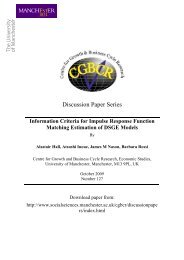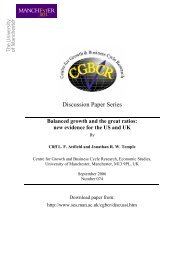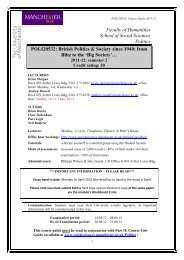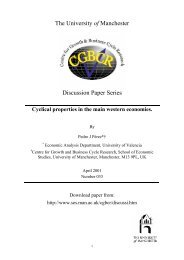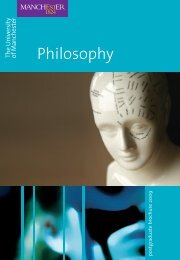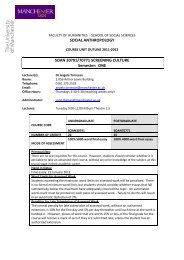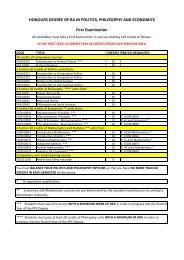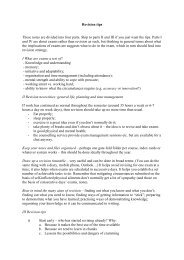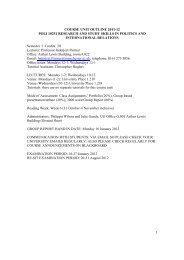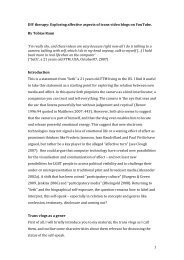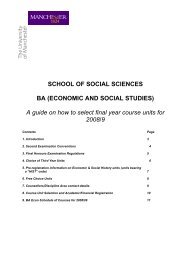CHNN 22, Spring 2008 - School of Social Sciences
CHNN 22, Spring 2008 - School of Social Sciences
CHNN 22, Spring 2008 - School of Social Sciences
Create successful ePaper yourself
Turn your PDF publications into a flip-book with our unique Google optimized e-Paper software.
Sobhanlal Datta Gupta. Comintern and the Destiny <strong>of</strong> Communism in India, 1919-<br />
1943. Dialectics <strong>of</strong> Real and a Possible History, Calcutta: Seribaan, 2006. xxii +<br />
pp329, ISBN: 8187492171.<br />
T<br />
his is the first book-length attempt to consider the implications <strong>of</strong> the newly available<br />
archival material for the Comintern’s policy towards India. Its main sources are the<br />
documents obtained by Pr<strong>of</strong>essor Datta Gupta and his colleagues from RGASPI and other<br />
Moscow archives in 1995, which have been published in Purabi Roy et al. (eds), Indo-Russian<br />
Relations 1917-1947: Select Documents from the Archives <strong>of</strong> the Russian Federation (2 vols, The<br />
Asiatic Society, Calcutta, 1999-2000). These are in the main drawn from the 495/68 and 495/68a<br />
series on the Communist Party <strong>of</strong> India, supplemented by the papers <strong>of</strong> the Indian Commission<br />
(495/42), the Eastern Secretariat (495/154), the Kuusinen Secretariat (495/16) and the papers <strong>of</strong><br />
the Comintern congresses and plenums. For the book under review, Pr<strong>of</strong>essor Datta Gupta also<br />
uses the papers <strong>of</strong> the CPGB – which at times had formal responsibility for Indian work – both in<br />
Moscow and Manchester and the material collected by Horst Krueger in Berlin.<br />
The result is a massively authoritative account <strong>of</strong> Comintern policy towards India. Each twist and<br />
turn – and there are lots <strong>of</strong> these – is carefully explained with detailed reference to the original<br />
sources, and to past and emerging historiography. It is hard to see how, as an account <strong>of</strong> Comintern<br />
policymaking, it could have been done with greater care or thoroughness. As well as the series <strong>of</strong><br />
chronologically-structured chapters tracking the policies, there is also an introductory chapter<br />
providing a valuable overview <strong>of</strong> the recent historiography <strong>of</strong> the Comintern, and another <strong>of</strong>fering<br />
the fullest account yet <strong>of</strong> the careers and fates <strong>of</strong> the Indian revolutionaries in Moscow.<br />
The main lines <strong>of</strong> the argument may be already familiar to readers <strong>of</strong> the <strong>CHNN</strong>. They were<br />
summarised by Pr<strong>of</strong>essor Datta Gupta in a paper he gave at a conference in Manchester in 2002<br />
which was summarised in issue 13. 1 What the new material shows, he suggests, is that the <strong>of</strong>ficial<br />
Comintern line was always questioned by alternatives: voices <strong>of</strong> ‘dissent and difference, resistance<br />
and protest’ which it marginalized or eliminated, but which still left traces in the archival record.<br />
For example, the familiar ultra-leftism <strong>of</strong> M N Roy in the early 1920s was contested by other<br />
positions, such as those <strong>of</strong> the Indian Revolutionary Association based in Tashkent and the Berlin<br />
group dominated by Virendranath Chattopadhyaya. Both <strong>of</strong> these groups thought, contra Roy, that<br />
a functioning Communist Party in India was still a distant prospect, and that a working alliance<br />
with bourgeois nationalism was desirable or necessary for the present. It is also clear that in 1930-<br />
31 there were, within the Comintern, multiple perspectives on the meaning and value <strong>of</strong> Gandhian<br />
civil disobedience. Even after the elimination <strong>of</strong> alternatives within the Comintern organisation,<br />
alternative strategies were argued for in India, especially over the correct relationship to be<br />
adopted to the Congress <strong>Social</strong>ist Party in the late 1930s, to Gandhian satyagraha and the civil<br />
disobedience movements <strong>of</strong> 1940-41, to the mass anti-imperialist revolt <strong>of</strong> August 1942, and to the<br />
Pakistan question. Some, perhaps most, <strong>of</strong> these alternative visions were known about in broad<br />
terms from earlier accounts. But the detailed arguments they contained are new. Readers who<br />
want to follow the detail can do so by reading Indo-Russian Relations, which reproduces most <strong>of</strong><br />
the documentation in full, while using Comintern and the Destiny <strong>of</strong> Communism as an<br />
explanatory guide to the debate.<br />
However, the purpose <strong>of</strong> the book is not only to uncover these forgotten voices but also to ask ‘what<br />
could have possibly happened in history had these alternatives been known and given a trial’. The<br />
book’s counter-factual arguments are ambitious. They do not merely ask whether the Comintern<br />
might have produced a different line towards India or the other colonised countries, but whether<br />
the Comintern might, under different conditions, have been a different kind <strong>of</strong> organisation<br />
altogether, one truer to its initial leninist design, or less Russified, or less monolithic. In proposing<br />
this counter-factual, Pr<strong>of</strong>essor Datta Gupta wants to challenge the dominant perspectives on<br />
Indian communism in India itself, which he argues is ‘still heavily dominated by the spirit <strong>of</strong><br />
Stalinism’ and unreceptive to the flow <strong>of</strong> revisionist accounts <strong>of</strong> the work <strong>of</strong> Comintern since the<br />
opening <strong>of</strong> the Russian archives. It is ‘not yet prepared’, he suggests, ‘to see its own face in the<br />
mirror <strong>of</strong> history’.<br />
There are four key moments at which it is suggested that this alternative structure and these<br />
alternative perspectives might have made a positive difference. The first was at the birth <strong>of</strong> Indian<br />
communism, when alternative strategies to those <strong>of</strong> M N Roy, all <strong>of</strong> them less hostile to Congress<br />
59



